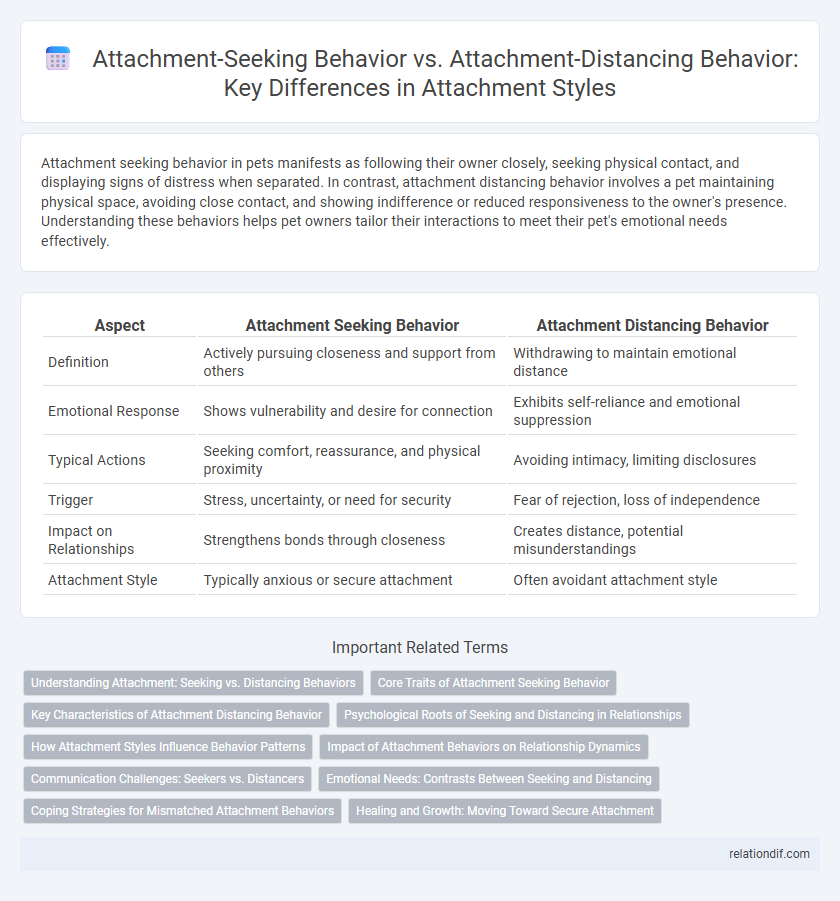Attachment seeking behavior in pets manifests as following their owner closely, seeking physical contact, and displaying signs of distress when separated. In contrast, attachment distancing behavior involves a pet maintaining physical space, avoiding close contact, and showing indifference or reduced responsiveness to the owner's presence. Understanding these behaviors helps pet owners tailor their interactions to meet their pet's emotional needs effectively.
Table of Comparison
| Aspect | Attachment Seeking Behavior | Attachment Distancing Behavior |
|---|---|---|
| Definition | Actively pursuing closeness and support from others | Withdrawing to maintain emotional distance |
| Emotional Response | Shows vulnerability and desire for connection | Exhibits self-reliance and emotional suppression |
| Typical Actions | Seeking comfort, reassurance, and physical proximity | Avoiding intimacy, limiting disclosures |
| Trigger | Stress, uncertainty, or need for security | Fear of rejection, loss of independence |
| Impact on Relationships | Strengthens bonds through closeness | Creates distance, potential misunderstandings |
| Attachment Style | Typically anxious or secure attachment | Often avoidant attachment style |
Understanding Attachment: Seeking vs. Distancing Behaviors
Attachment seeking behaviors involve actively pursuing closeness, comfort, and support from significant others, often indicating a secure or anxious attachment style characterized by emotional availability and trust. In contrast, attachment distancing behaviors reflect a tendency to withdraw, minimize emotional expression, or avoid intimacy, commonly associated with avoidant attachment styles that prioritize self-reliance and emotional control. Recognizing these contrasting patterns enhances understanding of individual differences in relationship dynamics and emotional regulation within attachment theory.
Core Traits of Attachment Seeking Behavior
Attachment seeking behavior is characterized by a strong desire for closeness, security, and emotional connection with attachment figures. Core traits include proximity maintenance, active communication, and seeking comfort during stress or uncertainty. Individuals exhibiting this behavior often display high levels of trust, dependence, and a need for reassurance to regulate their emotions effectively.
Key Characteristics of Attachment Distancing Behavior
Attachment distancing behavior is characterized by emotional suppression, avoidance of intimacy, and a strong desire for independence in relationships. Individuals exhibiting this behavior often minimize the importance of close bonds and may appear self-reliant or emotionally distant. This pattern can result from early attachment experiences where caregivers were inconsistent or unresponsive, leading to difficulties in trust and vulnerability in adult relationships.
Psychological Roots of Seeking and Distancing in Relationships
Attachment seeking behavior stems from early experiences of consistent caregiver responsiveness, fostering a sense of security and trust that motivates individuals to pursue closeness and support in relationships. In contrast, attachment distancing behavior often originates from childhood encounters with neglect or rejection, leading to emotional self-protection and avoidance of intimacy to minimize vulnerability. These psychological roots shape adult interpersonal dynamics by influencing how individuals regulate emotional needs and navigate relational dependency.
How Attachment Styles Influence Behavior Patterns
Attachment styles significantly influence behavior patterns by shaping how individuals seek or distance themselves in relationships. Secure attachment fosters attachment-seeking behaviors, characterized by comfort with intimacy and reliance on others for support. In contrast, avoidant attachment promotes attachment distancing behaviors, leading to emotional withdrawal and reluctance to depend on others.
Impact of Attachment Behaviors on Relationship Dynamics
Attachment seeking behavior fosters emotional intimacy and trust, promoting secure bonds and effective communication within relationships. Conversely, attachment distancing behavior often leads to emotional withdrawal and decreased responsiveness, which can create misunderstandings and relational instability. These contrasting attachment strategies significantly influence relationship satisfaction and conflict resolution patterns over time.
Communication Challenges: Seekers vs. Distancers
Attachment seeking behavior involves a strong desire for closeness and reassurance, often leading to persistent communication attempts that can overwhelm distancers. Attachment distancing behavior is characterized by a preference for independence and emotional space, causing minimal engagement and withdrawal during interactions. These opposing communication styles create challenges such as misunderstandings, unmet emotional needs, and cyclical conflict patterns between seekers and distancers.
Emotional Needs: Contrasts Between Seeking and Distancing
Attachment seeking behavior is characterized by a strong desire for closeness, comfort, and emotional support, fulfilling fundamental emotional needs for security and connection. In contrast, attachment distancing behavior involves withdrawal and avoidance of intimacy, often as a protective response to unmet emotional needs or fear of vulnerability. These contrasting behaviors reflect differing strategies for managing emotional needs related to trust, safety, and emotional regulation within relationships.
Coping Strategies for Mismatched Attachment Behaviors
Attachment seeking behavior involves actively pursuing closeness and support from others, while attachment distancing behavior is characterized by withdrawing and maintaining emotional distance to protect oneself. Coping strategies for mismatched attachment behaviors include developing awareness of one's attachment style, practicing effective communication to express needs clearly, and fostering emotional regulation techniques to manage anxiety or avoidance during interpersonal conflicts. Adapting these strategies helps individuals navigate relational tensions when partners exhibit opposing attachment tendencies.
Healing and Growth: Moving Toward Secure Attachment
Attachment seeking behavior promotes emotional healing by fostering trust and connection, essential for developing secure attachments. In contrast, attachment distancing behavior often indicates underlying fears of intimacy, which can hinder personal growth and emotional regulation. Embracing vulnerability and consistent positive interactions enables individuals to transition from insecure patterns toward secure attachment, facilitating sustained healing and relational resilience.
attachment seeking behavior vs attachment distancing behavior Infographic

 relationdif.com
relationdif.com